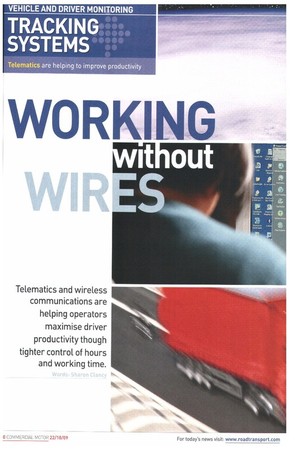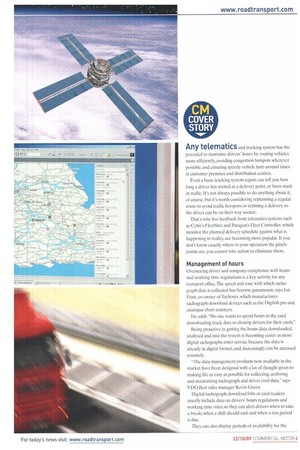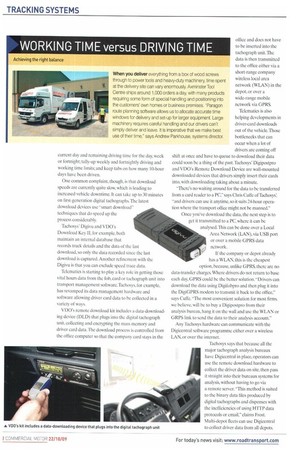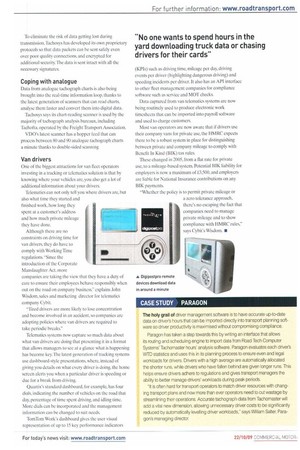WORKING
Page 40

Page 41

Page 42

Page 43

If you've noticed an error in this article please click here to report it so we can fix it.
Any telematics and tracking system has the potential to maximise drivers' hours by routing vehicles more efficiently, avoiding congestion hotspots wherever possible, and ensuring speedy vehicle turn-around times at customer premises and distribution centres.
Even a basic tracking system report can tell you how long a driver has waited at a delivery point, or been stuck in traffic. It's not always possible to do anything about it, of course, but its worth considering replanning a regular route to avoid traffic hotspots, or retiming a delivery so the driver can be on their way sooner.
That's why live feedback from telematics systems such as Cybit's FleetStar and Paragon's Fleet Controller, which monitor the planned delivery schedule against what is happening in reality, are becoming more popular. If you don't know exactly where in your operation the pinchpoints are, you cannot take action to eliminate them.
Management of hours Overseeing driver and company compliance with hours and working time regulations is a key activity for any transport office. The speed and ease with which tachograph data is collected has become paramount, says Ian Frost, co-owner of Tachosys, which manufactures tachograph download devices such as the Digifob pro and analogue chart scanners.
He adds: "No one wants to spend hours in the yard downloading truck data or chasing drivers for their cards."
Being proactive in getting the hours data downloaded, analysed and into the system is becoming easier as more digital tachographs enter service because the data is already in digital format, and. increasingly, can he accessed remotely.
The data management products now available in the market have been designed with a lot of thought given to making life as easy as possible for collecting, archiving and maintaining tachograph and driver card data," says VDO fleet sales manager Kevin Green.
Digital tachograph download fobs or card readers usually include data on drivers' hours regulations and working time rules, so they can alert drivers when to take a break; when a shift should end; and when a rest period is due.
They can also display periods of availability for the current day and remaining driving time for the day, week or fortnight; tally-up weekly and fortnightly driving and working time limits; and keep tabs on how many 10-hour days have been driven.
One common complaint, though, is that download speeds are currently quite slow, which is leading to increased vehicle downtime. It can take up to 30 minutes on first-generation digital tachographs. The latest download devices use -smart download" techniques that do speed up the process considerably.
Tachosys' Digivu and VDO's Download Key II, for example, both maintain an internal database that records truck details and the data of the last download, so only the data recorded since the last download is captured. Another refinement with the Digivu is that you can exclude speed trace data.
Telematics is starting to play a key role in getting those vital hours data from the fob, card or tachograph unit into transport management software. Tachosys. for example, has revamped its data management hardware and software allowing driver card data to he collected in a variety of ways.
VDO's remote download kit includes a data-downloading device (DLD) that plugs into the digital tachograph unit, collecting and encrypting the mass memory and driver card data. The download process is controlled from the office computer so that the company card stays in the office and does not have to be inserted into the tachograph unit.The data is then transmitted to the office either via a short-range company wireless local area network (WLAN) in the depot, or over a wide-range mobile network via GPRS.
Telematics is also helping developments in driver-card downloads out of the vehicle. Those bottlenecks that can occur when a lot of drivers are coming off shift at once and have to queue to download their data could soon be a thing of the past. Tachosys' Digipostpro and VDO's Remote Download Device are wall-mounted downloaded devices that drivers simply insert their cards into, with downloading taking about a minute.
"There's no waiting around for the data to be transferred from a card reader to a PC," says Chris Cuffe of Tachosys: -and drivers can use it anytime, so it suits 24-hour operation where the transport office might not he manned."
Once you've download the data, the next step is to get it transmitted to a PC, where it can be analysed. This can be done over a Local Area Network (LAN), via USB port or over a mobile GPRS data network.
If the company or depot already has a WLAN, this is the cheapest
option, because, unlike GPRS, there are no data-transfer charges. Where drivers do not return to base each day, GPRS could be the better solution. "Drivers can download the data using Digifobpro and then plug it into the DigiGPRS modem to transmit it back to the office," says Cuffe. -The most convenient solution for most firms, we believe, will be to buy a Digipostpro from their analysis bureau, hang it on the wall and use the WLAN or GRPS link to send the data to their analysis account."
Any Tachosys hardware can communicate with the Digicentral software programme either over a wireless LAN, or over the internet.
Tachosys says that because all the major tachograph analysis bureaux have Digicentral in place, operators can use the remote download hardware to collect the driver data on site, then pass it straight into their bureaux systems for analysis, without having to go via a remote server. "This method is suited to the binary data files produced by digital tachographs and dispenses with the inefficiencies of using FITTP data protocols or email," claims Frost. Multi-depot fleets can use Digicentral to collect driver data from all depots. To eliminate the risk of data getting lost during transmission,Tachosys has developed its own proprietary protocols so that data packets can he sent safely even over poor quality connections, and encrypted for additional security. The data is sent intact with all the necessary signatures.
Coping with analogue
Data from analogue tachograph charts is also being brought into the real-time information loop, thanks to the latest generation of scanners that can read charts, analyse them faster and convert them into digital data.
Tachosys says its chart-reading scanner is used by the majority of tachograph analysis bureaux, including Tachofta, operated by the Freight Transport Association.
VDO's latest scanner has a hopper feed that can process between 80 and 90 analogue tachograph charts a minute thanks to double-sided scanning
Van drivers
One of the biggest attractions for van fleet operators investing in a tracking or telematics solution is that by knowing where your vehicles are, you also get a lot of additional information about your drivers.
Telematics can not only tell you where drivers are, but also what time they started and finished work, how long they spent at a customer's address and how much private mileage they have done.
Although there are no constraints on driving time for van drivers, they do have to comply with Working lime regulations."Since the introduction of the Corporate Manslaughter Act, more companies are taking the view that they have a duty of care to ensure their employees behave responsibly when out on the road on company business," explains John Wisdom, sales and marketing director for telematics company Cybit.
'Tired drivers are more likely to lose concentration and become involved in an accident, so companies are adopting policies where van drivers are required to take periodic breaks."
Telematics systems now capture so much data about what van drivers are doing that presenting it in a format that allows managers to see at a glance what is happening has become key.'The latest generation of tracking systems use dashboard-style presentations, where, instead of giving you details on what every driver is doing. the home screen alerts you when a particular driver is speeding or due for a break from driving.
Quartix's standard dashboard, for example, has four dials, indicating the number of vehicles on the road that day, percentage of time spent driving, and idling time. More dials can be incorporated and the management information can be changed to suit needs.
TomTom Work's dashboard gives the user visual representation of up to 15 key performance indicators
(KPIs) such as driving time, mileage per day, driving events per driver (highlighting dangerous driving) and speeding incidents per driver. It also has an API interface to other fleet management companies for compliance software such as service and MOT checks.
Data captured from van telematics systems are now being routinely used to produce electronic work timesheets that can be imported into payroll software and used to charge customers.
Most van operators are now aware that if drivers use their company vans for private use, the FIMRC expects there to be a robust system in place for distinguishing between private and company mileage to comply with Benefit In Kind (BIK) tax rules.
These changed in 2005, from a flat rate for private use, to a mileage-based system. Potential BIK liability for employers is now a maximum of .E3,500, and employers are liable for National Insurance contributions on any BIK payments.
"Whether the policy is to permit private mileage or a zero tolerance approach, there's no escaping the fact that companies need to manage private mileage and to show compliance with HMRC rules," says Cybit's Wisdom. •
















































































































































